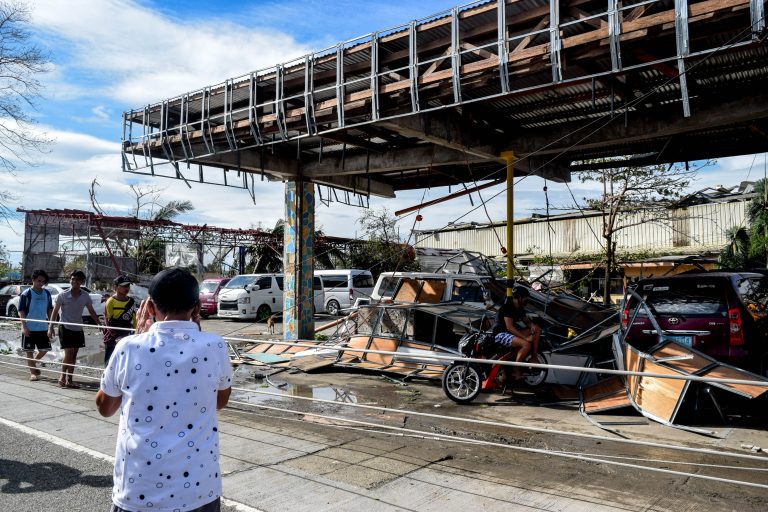
Developing capacity for post-typhoon disaster waste management in Lautoka, Fiji, and Makati, Philippines
Keywords
Circular economy · Contingency planning · Debris management · Disaster waste management · Global South · Resource recovery
HIGHLIGHTS
- Participating cities developed their disaster waste management contingency plans.
- The Philippine Association for Disaster Waste Management was established.
- More than 20 local and international presentations were conducted to promote disaster waste management.
- Experience and outputs are shared through a website: https://disaster-waste.org/.
1. INTRODUCTION
In recent years, Asia and the Pacific have been hit by strong typhoons1 that caused widespread destruction. One of the most devastating was Typhoon Haiyan in 2013, which affected the Philippines, Vietnam, Mainland China, and Taiwan. Cyclone Winston in 2016 caused significant damage to Fiji and other South Pacific nations, while Typhoon Mangkhut in 2018 impacted the Philippines, Taiwan, Hong Kong, Macau, and Mainland China. The strong winds from these typhoons tore off roofs, windows, doors, and walls from houses and destroyed trees and other vegetation, leaving behind large amounts of wooden, metallic, plastic, and glass debris and waste scattered across a wide area. For example, Typhoon Haiyan generated 19 million tons of disaster waste in the Philippines, while Cyclone Winston produced 24,000 tons of disaster waste in Fiji (Ministry of the Environment, Japan [MOE Japan] & Japanese Society of Material Cycles and Waste Management [JSMCWM], 2018). In some cases, hazardous materials such as hospital and industrial waste were among the debris, which required careful collection and proper treatment.
Proper management of disaster waste is critical during the initial phase of disaster recovery (Asari et al., 2013; Brown, Milke, & Seville, 2011; Zhang, Cao, Li, Liu, & Huisingh, 2019). In catastrophic events such as Typhoon Haiyan, the sheer volume of waste generated can easily overwhelm local waste management capacity, impeding rescue operations and the delivery of humanitarian aid (ibid.). For instance, following Typhoon Nari in Taipei City in September 2001, it took over a month to dispose of 190,000 tons of waste, possibly due to inadequate estimation of the waste generated by typhoons and subsequent flooding (Chen, Tsai, Hsu, & Shen, 2007). Therefore, it is crucial to prepare in advance for scenarios where significant amounts of waste are generated by such disasters. This includes addressing policy gaps in disaster waste management (DWM) and addressing deficiencies in financial, technical, and institutional capacities (ibid.).
Disaster waste management consumes a significant portion of the disaster recovery cost (Crowley, 2017). Pre-disaster planning and capacity-building could significantly reduce costs (ibid.). To ensure efficient DWM, funding mechanisms, institutional arrangements, and assignment of roles to different stakeholders should be put in place before disaster strikes. This can lead to sound disaster waste management, resulting in both cost and time savings (ibid.). Statistical evidence provided by Crowley (2017) indicates that communities that have pre-disaster waste management arrangements tend to have more effective waste management processes than those without such arrangements.
Proper management of disaster waste can help to recover valuable materials, reduce pressure on the environment for virgin raw materials, and minimize greenhouse gas emissions. Effective DWM can thus support the promotion of a circular economy and climate change mitigation initiatives. However, most existing DWM guidelines are prepared by developed countries, such as the United States and Japan, without taking into account the context and available resources in Global South countries. It is crucial to develop and promote guidelines that consider the specific circumstances and available resources in such countries. This technical report highlights the experience and outputs of a capacity-development project for disaster waste management in two Global South countries, namely Fiji and the Philippines. The project received financial support from the Asia-Pacific Network for Global Change Research (APN), with additional funding from the Institute for Disaster Management and Reconstruction (IDMR) at Sichuan University.
The overall aim of the project was to develop the capacity of Lautoka City, Fiji and Makati City, Philippines, for effective post-typhoon DWM. The following were the specific objectives of the project:
- To raise awareness in and develop the capacity of the two participating cities to promote resource conservation and resource efficiency through waste prevention and by recovering valuable materials from typhoon-related disaster waste;
- To determine the training needs of the participating cities related to capacity-building for effective post-typhoon disaster waste management;
- To produce training materials and to deliver training on post-typhoon disaster waste management that can address the training needs of the participating cities;
- To assist participating cities in developing a typhoon-specific disaster waste management contingency plan using the participatory learning and action (PLA) approach;
- To promote international cooperation among the four participating universities, two cities, and United Nations Environment Program – International Environmental Technology Centre (UNEP-IETC) to facilitate knowledge sharing on post-typhoon disaster waste management based on the experiences and lessons learned from the project; and
- To share lessons learned from the post-typhoon disaster waste management project to a wider audience by utilising different avenues, such as a dedicated project website and publication of journal articles, policy briefs, and project reports.
Pradhan and Xu (2018) discuss various methods for managing disaster waste, including waste generated by typhoons. In another study, Brown and Milke (2016) examined the feasibility and effectiveness of recycling disaster waste in the aftermath of five disaster events, including Hurricane Katrina. To learn from prior studies, particularly those focused on storm-related disasters, the project team gathered lessons from previous investigations and sought to apply those lessons to the current project. The project team also followed established disaster waste management guidelines, such as those developed by the Joint United Nations Environment Program – Office for the Coordination of Humanitarian Affairs (UNEP/OCHA) Environment Unit (Joint UNEP/OCHA Environment Unit [JEU], 2013), the Ministry of the Environment, Japan, and the Japanese Society of Material Cycles and Waste Management (MOE Japan & JSMCWM, 2018).
2. METHODOLOGY
2.1. Raising awareness of the project
Separate launching programmes for the project were held in Makati City and Lautoka City in October 2019, with 50 participants in Makati and approximately 30 attendees in Lautoka (see Figure 1). Both events were held at the respective city halls, and the welcome address was given by the representative of the Mayor of Makati and the Chief Executive Officer (CEO) of Lautoka. The project team provided an overview of the project and introduced the partner organizations, while officials from the participating cities gave presentations on the state of municipal solid waste management in their areas, as well as their past experiences in managing disaster waste. The events concluded with a discussion among the attendees on ways to achieve the project objectives.
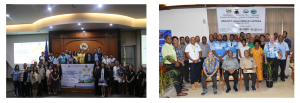
2.2. Training needs assessment
To identify gaps in current knowledge, skills and competency related to post-typhoon disaster waste management of city employees and other stakeholders, a detailed training needs assessment (TNA) was conducted in each participating city (Figure 2). In Lautoka, the TNA was carried out in September 2019 before the project launch, while the TNA in Makati was performed a few days after the launching. Data was gathered through questionnaire surveys, interviews and multistakeholder focus group discussions. The TNA instruments were based on materials produced by UNEP-IETC or its partner organisations, such as the Disaster Waste Management Guideline for Asia and the Pacific (MOE Japan & JSMCWM, 2018), the 2018 Caribbean Disaster Waste Management Training Programme (supported by UNEP-IETC), and several case studies from recent typhoon-related major disasters, including Typhoon Haiyan.
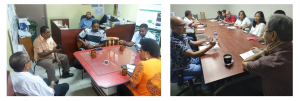
2.3. Production of training modules and delivery of training
The training needs assessment identified gaps in knowledge and skills related to post-typhoon disaster waste management among city employees and stakeholders. The project team developed training modules to address these gaps based on the findings. The modules covered topics such as (a) forecasting the types and amounts of disaster wastes, (b) disaster waste recycling and disposal options, and (c) preparing a temporary storage site (TSS). To provide expertise on TSS preparation, the project team sought the help of an external expert from JSMCWM. The main objective of the training was to equip participants with the knowledge and skills to create a typhoon-specific disaster waste management contingency plan. In total, six training activities were conducted under the project. The trainees were chosen by the two cities.
- Training of Trainers on DWM in Ateneo de Manila University from 15–16 January 2020 (20 participants) (Figure 3)
- Face-to-Face Training for Makati City stakeholders on 17 January 2020 (50 participants)
- Online Training for new Makati City staff on 24 March 2021 (45 participants)
- Mentoring Seminar for Makati City staff on 18 June 2021 (15 participants)
- DWM Contingency Planning Training Workshop and Stakeholder Consultation in Lautoka on 23 March 2022 (50 participants)
- Mentoring Seminar for Makati City staff on 6 May 2022 (15 participants)
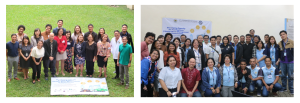
Before attending the training sessions, participants were asked to complete the online course “Disaster Waste Management: Best Practices and Tools” offered by the Environmental Emergencies Centre. By completing this course, participants were introduced to disaster waste management basics and better equipped to participate in the more comprehensive training modules. The online course, which takes approximately three hours to complete, was successfully finished by more than 30 participants.
2.4. Preparation of the DWM contingency plan
The major outputs of this project are the disaster waste management contingency plans of the two participating cities. Following the training sessions, the project team provided a suggested outline to the cities, including items such as the objectives of the contingency plan, relevant national laws and policies, and city ordinances. Other plans related to the disaster waste management contingency plan, such as the municipal solid waste management plan and the disaster risk management plan, were also included in the outline. Additionally, the suggested outline covered the forecast of the expected quantity of disaster wastes per type of material, disaster waste collection and removal strategies, identification of temporary storage sites, waste recycling and reuse options, final disposal sites, organisational chart, including assignment of roles and responsibilities, operations flowchart, and information to include in the appendices. The participating cities organised several meetings and workshops among their stakeholders and consulted with the project team for guidance and mentoring when needed.
2.5. Promoting international cooperation
The project team was composed of members from three sub-regions in the Asia-Pacific: East Asia (China and Japan), Southeast Asia (Philippines), and Oceania (Fiji). The team consisted of researchers from four reputable universities, namely Sichuan University, Kyoto University, Tongji University, and Ateneo de Manila University, who contributed their technical expertise in the capacity development project. Sichuan University runs the Institute for Disaster Management and Reconstruction (IDMR), with disaster waste management as one of its major areas of interest. The university also boasts a competitive Public Health programme, which provided valuable insights into the management of medical and healthcare waste. Tongji University and UNEP-IETC co-manage the UNEP-Tongji Institute of Environment for Sustainable Development (IESD), a think tank that conducts research on various topics, including climate change, disasters and conflicts, environmental governance, harmful substances, resource efficiency, environmental assessments, and technology transfer facilitation to developing countries. UNEP-IETC serves as the global centre of excellence for environmentally sound technologies, with a specific focus on waste management. Ateneo de Manila University’s Department of Environmental Science aims to prepare the next generation of environmental scientists to apply classroom concepts to real-world issues, making it a valuable partner in the capacity building project. The university’s Master in Disaster Risk and Resilience (MDRR) programme was designed to promote interdisciplinary and transdisciplinary approaches to risk management and resilience building, aligning with the interdisciplinary and transdisciplinary nature of this project. The four universities worked together to support the science-based decision-making of government and non-government stakeholders in the two participating cities.
2.6. Sharing lessons with a wider audience
Throughout the project, the activities were documented and shared on the dedicated project website (https://disaster-waste.org/). Knowledge products such as reports, policy briefs, scientific papers, photographs, and videos were made available on the website for researchers, policymakers, civil society organisations, and the general public to for easy accessibility. When available, the final version of the training materials will also be uploaded to the website, thus enabling widespread dissemination and adoption by the international community. The project team disseminated information about the capacity development project through presentations in academic conferences, webinars (as shown in Figure 4), workshops, training activities and non-academic conferences.
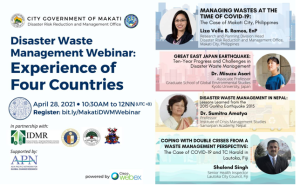
3. RESULTS AND DISCUSSION
3.1. Outputs, outcomes and impacts
The disaster waste management contingency plans of the two cities are the key outputs of this capacity development project. From 2020 to 2021, the project team organised and participated in various international and local conferences, webinars and training events to disseminate information about the project. As a result, the project helped generate significant interest in disaster waste management within the disaster risk reduction, environmental management, solid waste management and climate change stakeholder communities not only in Fiji and the Philippines, but also in other parts of the world.
Table 1 presents the outputs, outcomes and impacts of the project. This list is not exhaustive, as some of the anticipated outputs, including journal articles, are still in progress and undergoing peer review at the time of writing.
| Objective | Outputs | Outcomes | Impacts |
|---|---|---|---|
| A | Project launching in participating cities; closing workshop | Promoted awareness among stakeholders of the project | Getting city officials to include DWM in their disaster risk management programmes |
| B | Training needs assessments | Gained awareness of the DWM capacity gaps in each city | Recognising the most critical training needs and producing training modules to address these needs |
| C | Training modules; trainings; mentoring sessions | Addressed the training needs of participating cities | Having staff members with DWM knowledge and skills |
| D | DWM contingency plans (one per city) | Gained familiarisation of the participatory DWM contingency planning process | Obtaining the ability to prepare DWM contingency plans for other hazards |
| E | Face-to-face and virtual meetings; email updates; establishment of a new non-government organisation (NGO); Sendai Framework Voluntary Commitment; networking with and membership in DWM-related organisations | Enhanced cooperation among existing partners; developed cooperation with new partners | Strengthening of mutually beneficial relationships among partners that can be easily tapped and mobilised in the future |
| F | Project website; session at the Sustainability Research and Innovation (SRI) Congress 2022; DWM webinar (Figure 4); publications; media reports, videos and digital content; awards and recognition | Shared experiences in and lessons learned from the project; developed advocacy-related skills | Promotion of post-typhoon DWM to a wider audience |
3.2. Challenges during project implementation
In January 2020, the project team planned to conduct the DWM training of trainers at Ateneo de Manila University and the face-to-face DWM training in Makati. However, the sudden eruption of Taal Volcano led to delayed or cancelled flights, preventing our team member from Lautoka City from attending the training and meeting with their counterparts in Makati. Moreover, flights for our team members from Kyoto University from Manila back to Japan were also delayed. As a result of the volcanic eruption, several trainees from Makati were deployed to the disaster-affected areas to provide assistance and were unable to attend the training. These unforeseen events led to a lower number of participants than initially anticipated.
Up until January 2020, the project team was able to stay on schedule with the implementation of project activities. However, the outbreak of the COVID-19 pandemic had a significant impact on the project timeline. In response to the pandemic, the project team made the decision to suspend the remaining project activities, as the local partners in Lautoka and Makati were among the frontline responders to the pandemic as the team member in Lautoka is a public health official, while the team member in Makati works in the city’s Disaster Risk Reduction and Management Office. The project team felt it was important not to divert the attention of these local partners from their critical duties during the pandemic.
Until the end of August 2022, we were unable to return to Sichuan University in Chengdu, China, due to travel restrictions imposed by the COVID-19 pandemic. Two other team members from Sichuan University were also stranded in Tokyo and Montreal for some time.
One of the most significant activities in our project was the participatory preparation of a typhoon-specific disaster waste management contingency plan by our two participating cities. However, the DWM contingency planning was delayed as not all stakeholders in Lautoka and Makati had reliable Internet connections, and face-to-face modalities were still the most appropriate for this kind of participatory exercise. The project team initially allocated at least four months for this activity, but it was put on hold in Makati following lockdown in Metro Manila for most of 2020 and 2021. The main stakeholders were supposed to receive a face-to-face training on contingency plan preparation before the planning process could begin. On 6 May 2022, the project team had its second mentoring session with the Makati stakeholders to aid them with their contingency planing. In Lautoka, the contingency planning process started after the stakeholders conducted a training workshop on 23 March 2022.
While preparing the DWM contingency plan in Makati City, it became apparent that much of the information needed was not readily available. The core group in Makati eventually agreed that their initial DWM contingency plan would need to be updated once the necessary information became available. This is consistent with the principle that contingency plans are living documents that must be regularly revised or updated.
3.3. Missed opportunities
In 2020 and 2021, the Philippines was hit by a series of strong typhoons, resulting in the generation of a large volume of disaster waste. Unfortunately, due to safety concerns related to the COVID-19 pandemic, project team members were unable to visit the disaster-affected areas to conduct documentation and data-gathering, which would have been very useful for the capacity building project. For example, in December 2021, Typhoon Rai (locally known as Typhoon Odette) ravaged a vast area in central and southern Philippines. The typhoon caused widespread destruction, and it would have been another opportunity to document the disaster waste generated by a typhoon and observe how local and national government officials manage disaster debris if there had not been a pandemic.
3.4. Ways forward: Post-project activities
Thanks to this project, our team members were able to broaden their networks and establish partnerships with organisations that will continue to promote disaster waste management after the end of the APN project. The following are some of the activities:
- Expansion of the membership of the newly established Philippine Association for Disaster Waste Management (PADWM) and preparation of documents needed for the formal registration of the non-government organisation under the Securities and Exchange Commission.
- In October 2022, a proposed project titled “Science Advice on Disaster Waste Management: Enabling Local Governments to Practice and Promote Building Back Better, Circular Economy, and Climate Change Mitigation” submitted by the project leader was chosen by the International Network for Government Science Advice (INGSA) Asia chapter as one of the winners of its Grassroots Science Advice Promotion Awards 2022. Part of the award is a seed grant as well as guidance and mentorship from a distinguished member of the INGSA-Asia Steering Committee to organise science advice workshops. The new project will build on the accomplishments made under the APN project.
- The project team reprised the session “Disaster Waste Management Capacity Development in the Global South”, organised for the SRI Congress 2022 at the 2022 Conference of the Solid Waste Management Association of the Philippines (SWAPPCon 2022) on 17 November 2022.
- The project leader has been involved as a resource person on “Forecasting Types and Amount of Disaster Wastes” in the quarterly Disaster Waste Management Training organized by the Development Academy of the Philippines (DAP). Three DAP staff were among those who participated at the DWM training of trainers organised by the project team in January 2020.
- The project team, together with new partnerships developed during the implementation of the project, created a Sendai Framework Voluntary Commitment to conduct capacity development training activities and seminars in the coming two years.
4. CONCLUSION
This capacity development project is an example of an inter- and transdisciplinary endeavour that showcases multistakeholder involvement, including local and national government offices, academia, NGOs, the private sector and international organisations. The project emphasises the importance of preparing in advance for post-typhoon disaster waste management. Addressing training and policy gaps in disaster waste management, including deficiencies in existing financial, technical, institutional and human resource capacities, will assist participating cities in their disaster recovery efforts, even beyond the end of the project.
This project has been designed to support the efforts of the participating cities in achieving the Sustainable Development Goals (SDGs), with a particular focus on Goal 11 (Make cities and human settlements inclusive, safe, resilient and sustainable), Goal 12 (Ensure sustainable consumption and production patterns), and Goal 17 (Strengthen the means of implementation and revitalize the Global Partnership for Sustainable Development). It is hoped that this project will also contribute to Priority 4 of the Sendai Framework for Disaster Risk Reduction 2015–2030, which aims to enhance disaster preparedness for effective response and to “Build Back Better” in recovery, rehabilitation, and reconstruction. Furthermore, the waste sector is one of the largest contributors to greenhouse gas emissions. By reducing the amount of disaster waste going to landfills, the participating cities can make a significant contribution to reducing greenhouse gas emissions. While it is still too early to determine the full impact of the project, it is hoped that it has laid the groundwork for continued efforts to promote disaster waste management and sustainable development in the participating cities and beyond.
Disaster waste management is well-aligned with the concept of circular economy. By effectively implementing disaster waste management, material consumption can be reduced and waste can be minimised, thus alleviating pressures on the environment for virgin raw materials. The increased focus on DWM generated by this project is expected to contribute to the documentation of best practices and the development of policies that can enhance DWM in the participating cities as well as in other urban areas.
5. ACKNOWLEDGEMENTS
This technical report is based on the work generously supported by the APN project referenced CBA2019-09SY-Fernandez. We are extremely grateful to Professor Gretchen Kalonji, the Dean of the Institute for Disaster Management and Reconstruction (IDMR) at Sichuan University – Hong Kong Polytechnic University, for her support of this project since its inception. IDMR provided funding for the research component of the project. We would also like to express our appreciation to Mr Mahesh Pradhan and Ms Qing “Suzie” Xu of the United Nations Environment Programme International Environmental Technology Centre (UNEP-IETC) for their encouragement and guidance in pursuing this project.